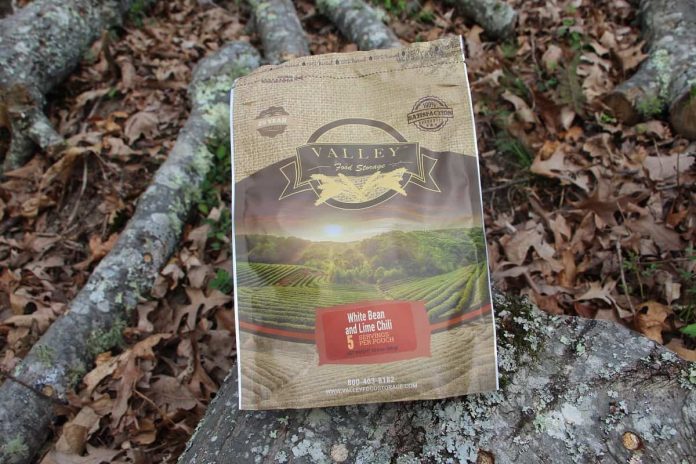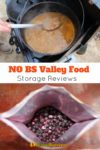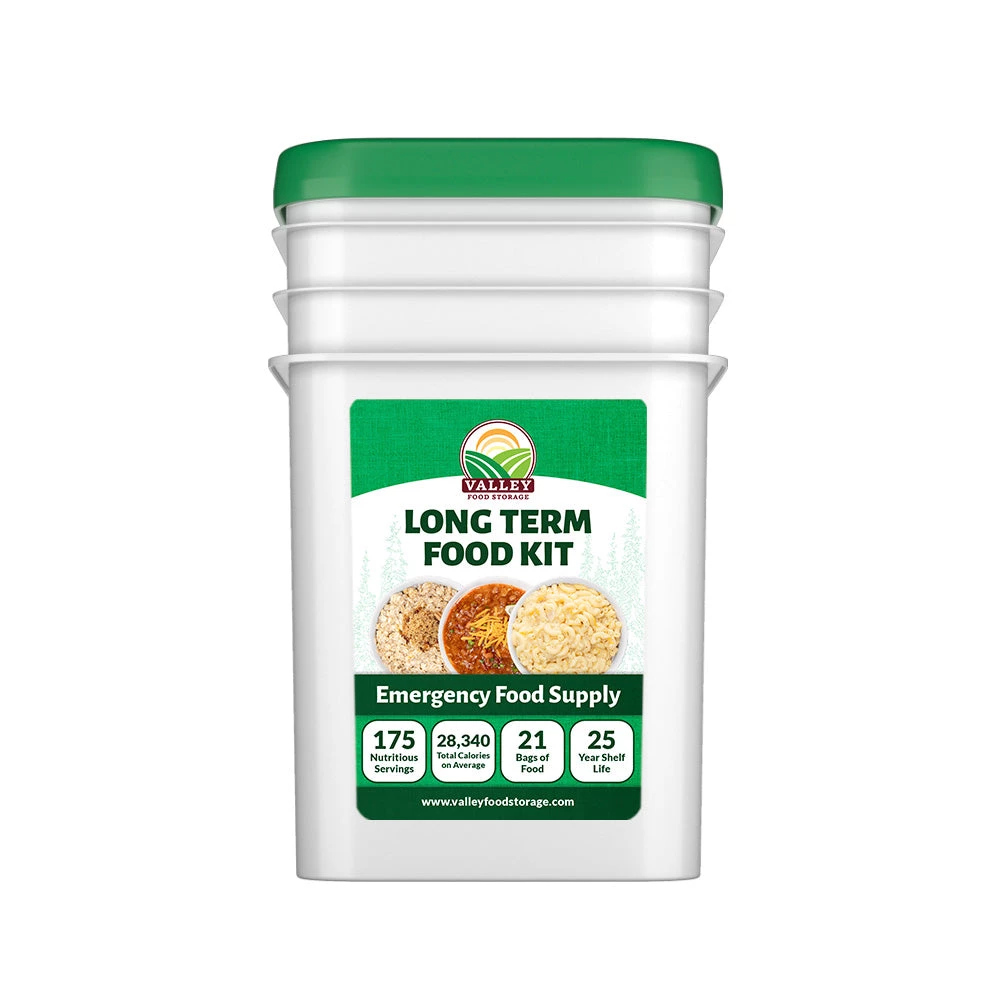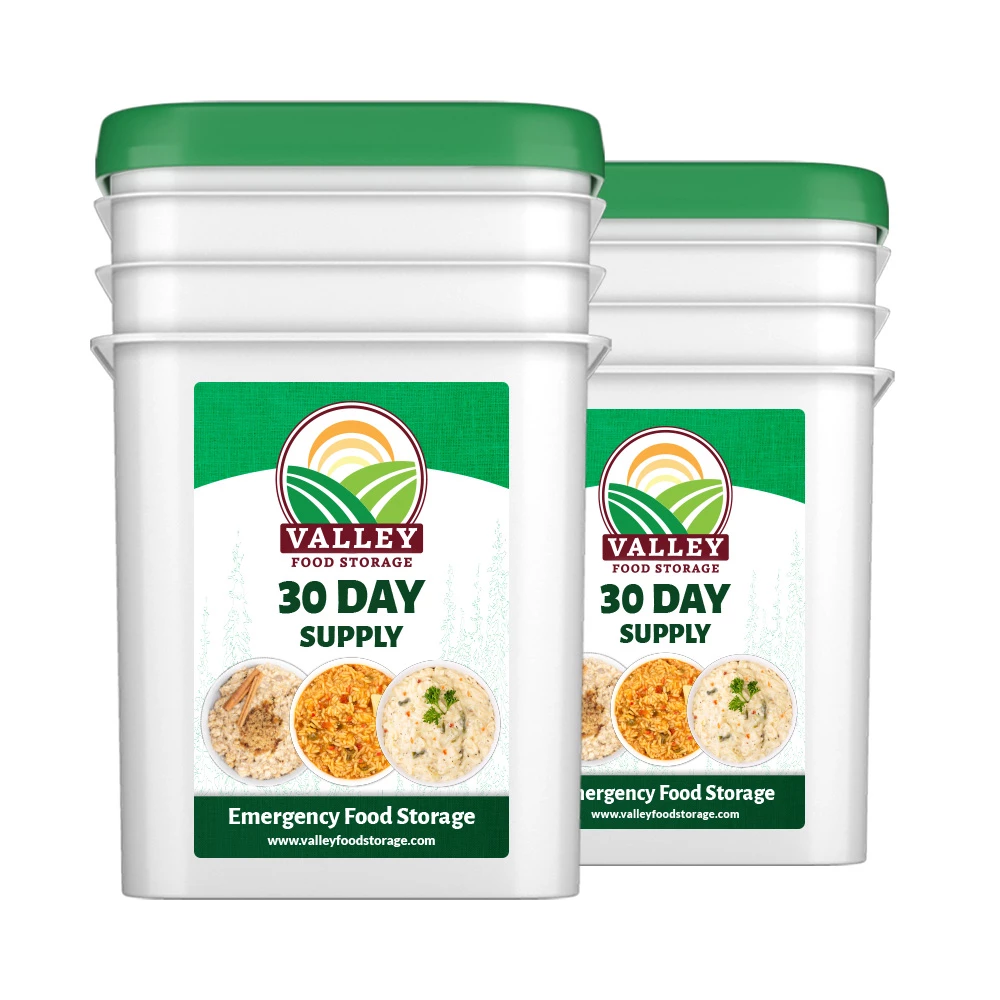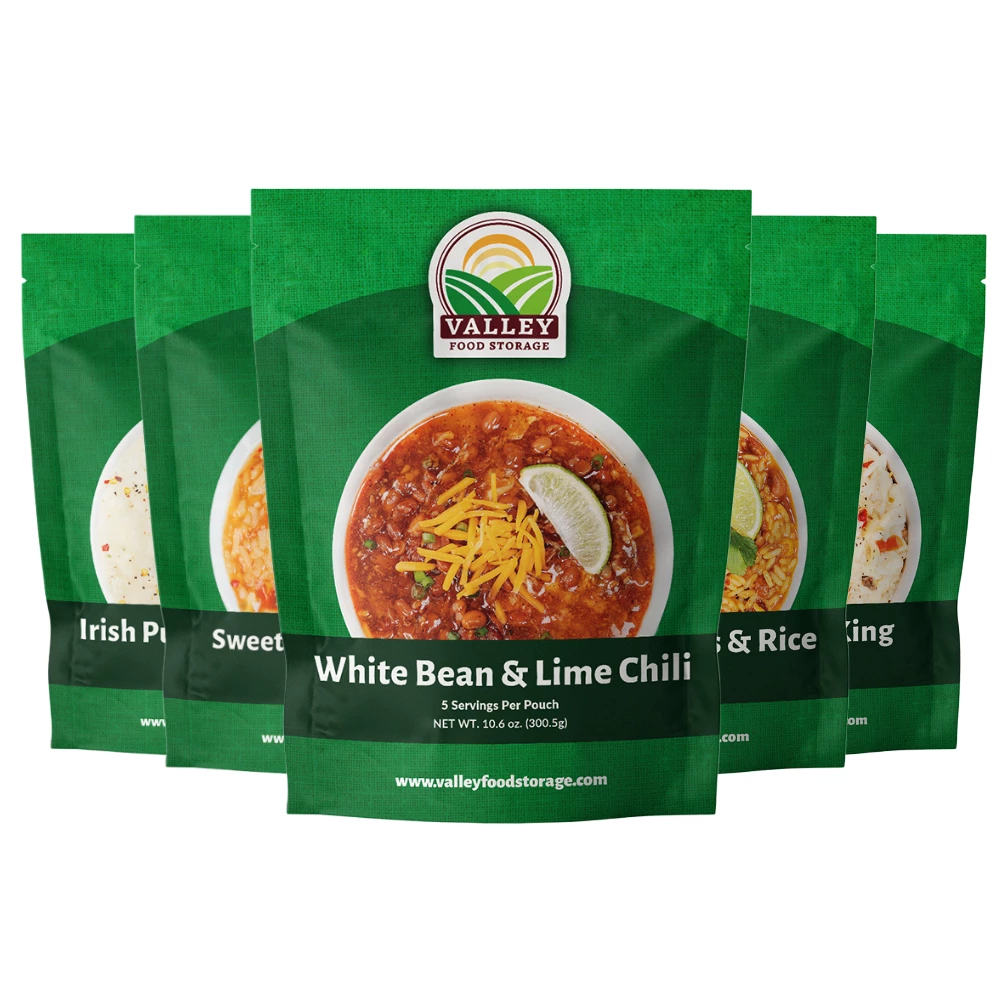Valley Food advertises its emergency food kits as being “simple food you can trust”. With no artificial ingredients, GMOs or fillers, this almost sounds too good to be true.
We look at how Valley Food’s meals stack up against the competition and whether they should be your first choice for long-term emergency food kits.
Let’s get started!
Valley Food Storage – Our Ratings
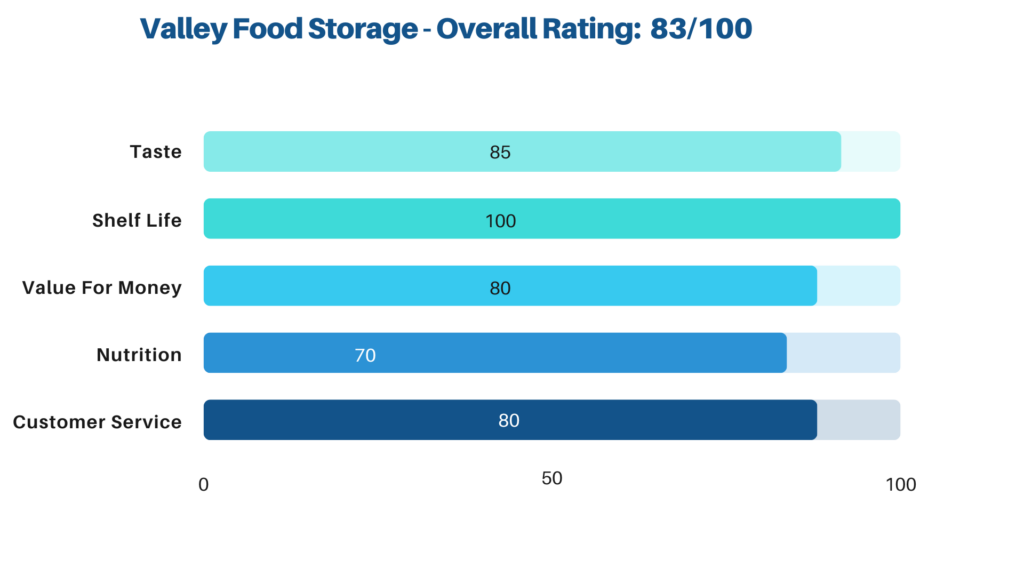
What We Think
Tasty meals with good flavor, made with (mostly) real ingredients. The brand is very transparent about serving sizes and total calories. Good value for money.
Key Takeaways
- Nice variety of meals with real flavor
- Kits with just one entrée – buy the meals you actually like
- Reasonable selection of vegetarian, gluten-free and dairy-free meals
- Good value for quality
- Lots of bulk food options
- 25-year shelf life for all food products
- Made in USA
- No savory breakfast options
- Most meals require cooking
What Types of Survival Food Does Valley Food Storage Offer?
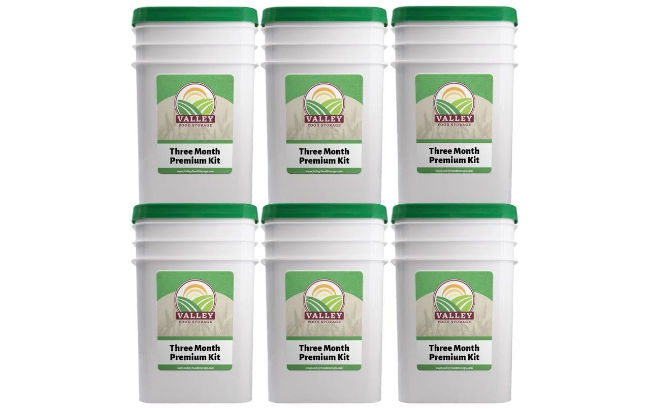
Like most emergency food companies, Valley Food Storage offers freeze-dried meals which are packed in pouches. The food pouches are primarily sold as “kits,” where they are packaged in buckets. In addition to meal kits, VFS also has kits containing bulk freeze-dried proteins, fruit and veggies.
Note: Sorting through the VFS options is somewhat confusing! Many of the products are listed in multiple categories and it isn’t always clear what the differences between options are. Furthermore, options regularly change.
Below I’ll go over the main emergency food options from VFS:
1. Long-Term Food Kits (175 Servings)
This is one of the main products offered by Valley Food Storage. It is a bucket that has 6 pouches of breakfasts, 10 pouches of entrees, and 5 pouches of bulk foods (cheese, milk, eggs). The shelf life of the foods is 25 years.
You can buy just one bucket, or you can buy the buckets in bundles for a better deal.
Be warned that the calories per serving are actually very low. It breaks down to 162 calories per serving! Granted, all emergency food meals have few calories per serving – but this is especially low. However, I do like that Valley Food Storage is very clear about what you are getting: they publish the total calories right on the bucket.
2. Long Term Kits (7 Days and 30 Days)
Instead of buying buckets by # of servings, you can also buy VFS kits by number of days.
With these options, you get 2000+ calories per day.
3. Meal Buckets
Like other emergency food companies, VFS sells “breakfast” and “entrée” buckets. But one cool thing about them is that they also sell buckets containing all the same entrée. Each meal bucket contains 10 pouches. There are 5 servings per pouch, so 50 servings per bucket.
For example, it’s possible to buy a bucket with just their chili, just their risotto, etc.
This is great if you particularly love one of their meals. It’s also great if you hate one of their meals. Instead of buying the variety packs (and getting stuck with meals you don’t like), you can just buy the meals you like.
You’ll find these listed under the “Bulk Food” section of their website.
4. Bulk Freeze-Dried Food
Valley Food Storage offers a larger selection of bulk freeze-dried ingredients than other food companies. These are sold in buckets as well as smaller packs.
They currently offer these bulk freeze dried foods:
- Meat – beef, chicken and sausage pieces
- Dairy – milk, chocolate milk and shredded cheese
- Fruit – apples, bananas, peaches, strawberries
- Vegetables – yellow squash, green beans, potato dices, corn, peas
- Powdered Eggs
5. Short Term Kits
Valley Food Storage also offers some “short term” kits. I personally don’t like these. They aren’t a good deal.
Another thing I don’t like is that the 72-hour kits have 20 servings of breakfast but 15 servings of entrees. Are you supposed to eat breakfasts for lunch too? Also, the “72 hour hurricane,” “72 hour blizzard” and regular “72 hour” kits all contain the exact same things!
But I do like that they have an entrée 5 pack. It’s pricy, but I look at this as a sampler pack which allows you to try their entrees before committing to a larger kit.
VFS Serving Sizes
As with all emergency food brands, the “serving size” of Valley Food Storage meals is very low:
- Breakfasts – 140-290 calories
- Lunches and Dinners – 150-340 calories (mostly 200-300 calories)
However, I love that VFS actually lists how many calories are in each bucket. You know exactly what you are getting (without having to do any complicated math).
Also, VFS 30-day kits are based on 2,000 calories per day. In an emergency situation, especially where you are mostly sitting around, this is more than adequate to meet most people’s needs.
Key Criteria and Our Ratings
Let’s see if Valley Food’s meals are everything they claim them to be.
Range of Meals
Primal Rating:
Valley Food Storage’s full range consists of 6 breakfast options and 12 entree options.
I’m quite impressed with their entrees. There are the usual staples that you’re used to seeing if you’ve tested freeze-dried food – pasta primavera, mac and cheese, tomato soup and various types of oatmeal and cereal – but there are also unique dishes that you may not find elsewhere. Irish cheddar potato soup and mango habanero chili were two of the mains that caught my eye.
The only thing that feels missing is a savory breakfast option.
Entrees:
- Mango Habanero chili (Veg, Vegan, GF)
- Mac and cheese 270 calories
- Honey teriyaki 210 calories per serving
- Sweet and sour Asian rice 340 calories
- Italian wild risotto
- Pasta a la king
- Tomato basil soup 150 calories
- Fettuccine alfredo
- Pasta primavera 190 calories
- Irish pub cheddar potato soup
- Enchilada beans and rice (Veg, Vegan, GF)
- White bean and lime chili 220 calories
Breakfasts:
- Apple oatmeal
- Strawberry oatmeal (veg)
- Multigrain dried cereal (Veg)
- Strawberry cream of wheat (veg)
- Apple cream of wheat (Veg)
- Maple brown sugar oatmeal
Quality and Taste
Primal Rating:
The main meals and breakfasts are some of the tastiest on the market. They’re not high-end cuisine and may not live up to your home cooking standards, but for food that’s designed to last 25 years, they do a good job.
Some companies deliberately keep their meals fairly bland in an attempt to cater to all tastes. Fortunately, Valley Food Storage doesn’t do this. Their chilis have a bit of spice, without being overly hot, and the cheese and cream dishes have a good taste and texture. Special mention goes to the Irish cheddar potato soup which is a firm favorite with testers.
Overall, they’re not quite as good as Mountain House when it comes to taste, but they’re a decent (and cheaper) runner-up.
Valley Food Storage’s big selling point is its use of “real” quality ingredients, with no MSGs, artificial flavors, or hydrogenated oils. When you look at the back of the packets, the meals live up to these claims, proving that you can have long-life food without adding lots of chemicals!
Note that some of this flavor does come from “yeast extract” (which is basically MSG flavor enhancer). So don’t think you are getting completely “real” food!
The “meat” meals contain chicken or beef broth rather than actual lumps of meat, but you could top these up with beef, sausage or chicken from your protein pack. It would have been nice to see more vegetables in some of the meals, such as the wild risotto.
I’d recommend getting their fruit and vegetable bucket to supplement the meals and give you some sweet snacks.
Ease of Cooking
Primal Rating:
One thing that I really dislike about Valley Food Storage is that most meals need to be cooked.
It’s not always possible to cook during an emergency. I would have preferred meals which can be made with the “cold soak” method where you just pour water over them at wait for them to reconstitute. Meals by ReadyWise,for example, can be made this way.
To make matters worse, some of the VFS meals need to be cooked for a long time. The Wild Risotto and Enchilada Beans and Rice both require 20-23 minutes of cooking! This will blow through your fuel stockpile quickly.
Special Diet Options
Primal Rating:
On the Valley Food Storage website, you can search through the food options by these dietary options:
There aren’t too many meal options for these dietary restrictions. However, since you can buy buckets with just one type of meal, you aren’t stuck buying variety packs which contain meals you can’t eat.
I find it odd that the VFS website currently doesn’t have a filter for gluten-free food though. Some of their meals are GF and it would be nice if you could find them more easily.
How Healthy Are They?
Primal Rating:
Valley Food Storage gets a big thumbs up for having minimally processed food with few additives. It’s always reassuring when you can understand every ingredient in your meal.
One minor complaint about their website is that the nutritional information for the products included in the long-term kits isn’t included on the kit page, only the individual product pages. However, hidden in the footer is a nutrition page that collates the information for the meals and bulk food which makes it easier to compare different products.
Let’s get into the detail of what these meals contain.
Carbohydrates and Sugar
Most of the main meals have a carbohydrate base – rice, pasta or potato – as is typical for these types of meals.
Sugar sneaks its way onto the ingredients list of half the main meals but some of the higher-sugar dishes such as the mango habanero chili and sweet and sour rice also contain natural sugars from the fruit.
Despite some of the meals having high sugar levels, these are easy to spot as the ingredients list is so simple. No high-fructose corn syrup here!
Protein
Most VFS meals are very low in protein. However, the meals with beans actually do have a decent amount of protein per serving. Considering that you will probably need to eat two servings to meet calorie needs, the protein amount is more than adequate.
I’d still recommend supplementing the VFS meals with other protein, such as from their freeze-dried meat packs.
Sodium
Most of the entrees are fairly high in salt, but a couple stand out above the rest. One serving of the enchilada beans and rice contains a whopping 1210mg of sodium – 53% of your recommended daily allowance. If you were just having one serving, this wouldn’t be an issue, but for most people, two servings will make up a decent meal.
That said, several of the meals are less salty, so you could balance this out over the day by combining the beans and rice with the sweet and sour Asian rice or wild risotto which contain much less sodium.
Vitamins and Minerals
The meals contain small amounts of vitamins and minerals (relevant ones are included on ingredient labels) but generally not in sufficient quantities to meet your recommended daily allowance. In particular, the breakfasts don’t have as much calcium or other nutrients as I’d expect, given these are often fortified.
Adding servings of milk and freeze-dried meat to your meals will significantly boost your calcium, iron, potassium and vitamin D intake.
Shelf Life
Primal Rating:
All Valley Food’s emergency food has a 25-year shelf life, regardless of pack size. While you may be tempted to look at cheaper options for freeze-dried fruit, vegetables or milk, bear in mind that most packs you buy in the grocery store will only have a shelf life of a year or two.
Food is packaged in heavy-duty Mylar bags along with a food-safe oxygen absorber. This absorbs any oxygen trapped in the bag and is worth replacing in the bag if you’re having to open and reseal it over a few days. Just make sure it doesn’t end up in your mac and cheese!
The bags are packed into sturdy 5.3-gallon rectangular buckets to give extra protection from water, chemicals and pests.
One downside is that some of the pack sizes are quite large for a single person. Most of the entrees come in 5-serving packs, but the breakfasts are 10-serving packs, so you’ll be eating the same meal for several days. However, the Mylar bags are resealable and if you reuse the oxygen absorber, your food should stay good to eat for a while.
Cost and Value for Money
Primal Rating:
Like with other freeze-dried meal companies, Valley Food Storage kits are not cheap. Their daily meal kits (with 2,000 calories per day) end up costing around $12 to $14.50 per day. The larger the kit you buy, the cheaper it ends up being.
While $12 per day doesn’t seem expensive, bear in mind that the meals mostly consist of cheap carbs like oats and pasta. There is very little in terms of fruits and veggies. None of the meals have meat: “meat” meals actually just contain chicken or beef broth.
Despite this, Valley Food Storage still ends up being one of the cheapest emergency food suppliers. If you are on a very strict budget, I’d recommend doing some of your own food preps with Mylar bags and oxygen absorbers!
Availability
Primal Rating:
Valley Food meals are available on their website and you may occasionally come across their products in more mainstream stores such as Amazon.
There’s a 30-day return policy (shorter than many other companies), though you’ll have to cover your own shipping costs for returned items.
Most orders ship within five business days, but at periods of peak demand delivery understandably takes a lot longer.
Unlike some other companies, Valley Farm usually has clear information on these timescales and what they’re doing to expedite shipping front and center on their website.
Customer Service and Incentives
Primal Rating:
Valley Food offers a 100% satisfaction guarantee. Their Valley Rewards scheme offers discounts on purchases when you collect points.
Reviews of their customer service are mixed. While there are plenty of happy customers, they also seem to have some issues with delivering orders on time (though this can sometimes be the fault of the shipping agent rather than the supplier).
Don’t wait until disaster strikes to order.
Final Thoughts
Valley Food Storage came top overall in our comparison of the best emergency food suppliers and with good reason. They offer great-tasting food at a reasonable price with the option to add on bulk ingredients.
I’d recommend getting some of their 175-serving buckets and supplementing the meals in these with their bulk ingredient buckets. This will increase the calorie total while also giving you more flavor and nutrition.
Related
For further survival food companies reviews see:

